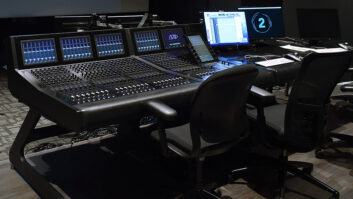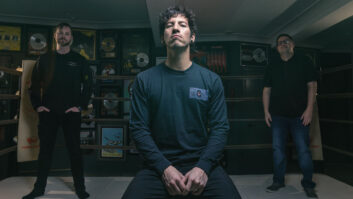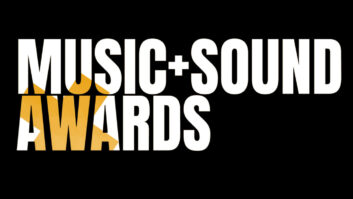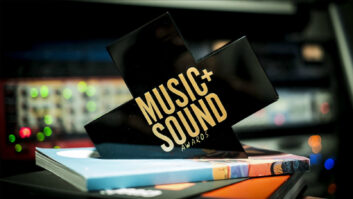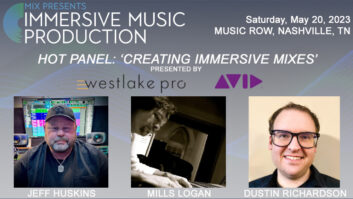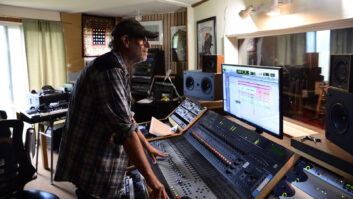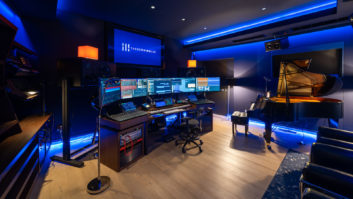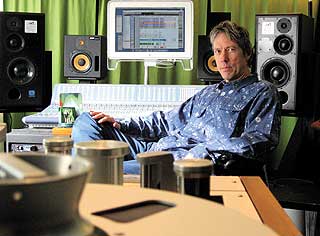
Ryan Ulyate’s private studio features a D-Command console, ATC monitors and a view of Topanga Canyon.
Photo: Judith Crow
Los Angeles-based engineer/producer Ryan Ulyate parlayed his hard work and his vision into a dream career. Since 2005, Ulyate has worked closely with Grammy Award-winning artist Tom Petty, primarily in Petty’s home studio; in Petty’s rehearsal space/recording studio, The Clubhouse; and in Ryan’s Place, Ulyate’s home studio in scenic Topanga Canyon. “I’m pretty good at recording and mixing, and as a producer I see myself as more of a collaborator with the artist; that’s my favorite thing to do,” Ulyate says.
Ulyate learned his craft in commercial facilities beginning in 1978. “That’s the most valuable education you can have,” he says. “You realize that there are as many different ways to make a record as there are people.” In 1997, Ulyate met producer Jeff Lynne, which led to his work on George Harrison’s final album project, Brainwashed, and the soundtrack for the November 2002 tribute to Harrison, Concert for George. “Right after that, Jeff was producing, along with Tom Petty and Mike [Campbell], Tom Petty’s Highway Companion album. After that, Tom started pulling me more into the things he was doing. Ever since then, I’ve been co-producing his stuff. It’s a great relationship.” Ulyate worked with Petty and Campbell on their latest release, the CD box set Tom Petty and The Heartbreakers: The Live Anthology, which presents selected tracks from live concert recordings spanning 1978-2007.
Notably, Ulyate’s studio is tightly integrated with Petty’s home studio for the smoothest possible workflow between the two rooms. “I made sure that Tom’s room had the exact same Pro Tools system — the same amount of cards, a similar I/O, the same plug-ins, software and speakers,” Ulyate says. Ulyate’s studio is housed inside of a 12×24-foot structure on his property; he treated his room acoustically with shoji screens, foam, curtains and bass traps, and configured it for 5.1 surround with five ATC SCM50ASL Pro three-way midfield monitors. “Those ATCs reveal so much more detail in the midrange,” he says. He also uses KRK 7000s, a Bag End Infrasub-18 Pro subwoofer and Auratone speakers.
Ulyate’s studio has a Pro Tools HD6 system, Pro Tools Version 7.4, a quad core Mac G5 PowerPC, a 24-channel Digidesign D-Command console and two Digidesign 192 I/O interfaces configured with 24 inputs and 16 outputs. Ulyate uses a dbx 120A Subharmonic Synthesizer that “adds a bit more thump to kick drums and tom-toms, and sometimes bass. I do everything else inside the box with plug-ins.” Ulyate’s main plug-ins include the Massenburg DesignWorks Parametric EQ and Universal Audio’s UAD 1176 TDM plug-in, which is no longer supported. “That’s why I’ve held onto my old machine,” he says of his Mac. “As for reverb, it’s pretty much between [Audio Ease] Altiverb and [Digidesign’s] TL Space. I like Eventide and Sound Toys [plug-ins] for effects.
“[This] studio came into its own around 2005, and it had everything to do with being able to mix inside the box in Pro Tools,” Ulyate says. “The most important thing for me is being able to take the time to mix. With more time, I feel I can mix better.”
The Veteran Producer/Engineer Discusses Mixing and Mastering the CD/DVD Box Set Tom Petty and The Heartbreakers: The Live Anthology
In November 2009, Reprise Records released the CD box set Tom Petty and The Heartbreakers: The Live Anthology, a collection of selected tracks from the band’s concert performances that were recorded between 1978 and 2007. For this project, co-producers Tom Petty, Mike Campbell and Ryan Ulyate reviewed and compared hundreds of hours of archival recordings, and chose what they felt were the “best” tracks for this compilation.
The producers set about assembling, sequencing, mixing and re-mastering the selected tracks for five differently packaged configurations for The Live Anthology: a 48-track digital download version; a “Standard” set comprising 48 tracks on four CDs; a “Deluxe” set (available only from Best Buy) offering 62 tracks on five CDs, two DVDs of previously unreleased documentary and concert material, a vinyl LP of the re-mastered 1976 Official Live ’Leg bootleg album and one Blu-ray disc of all 62 tracks in both stereo and surround sound; the online-only Tom Petty and The Heartbreakers Superhighway Tour, which delivers 48 tracks as MP3 and FLAC files; and, finally, a “Vinyl Deluxe Box Set” with 51 tracks mastered directly from the uncompressed 24-bit/96k files and pressed onto seven 180-gram audiophile-quality vinyl LPs.
To transfer audio from the original tapes—comprising about 245 reels—into the digital domain, engineer/producer Ulyate relied on Campbell’s 24-track Studer A 827, and Ulyate also used a 2-track Ampex ATR 100 for transferring the only “legacy” mix that was used on the Live Anthology (“Spike,” which was mixed by the late Don Smith). He also says that a Dolby MT Series SR/A-type processor with 24 cards, “a big rackmounted unit that decodes both SR- and A-type noise reduction,” was critical in working with the original analog audio for this project.
I spoke with Ulyate (pronounced “ul” as in “dull” and “yate” as in “date”) by phone from his home in Los Angeles about his work behind the scenes on Tom Petty and The Heartbreakers: The Live Anthology, which mainly took place in his project studio, Ryan’s Place, and in Petty’s home studio. Along the way, Ulyate shared his thoughts about audio quality in consumer products, the loudness wars and the promise of Blu-ray as a delivery format for audio.
Clearly, considering its size and scope, The Live Anthology was an ambitious undertaking from both creative and technical standpoints.
The story behind it was that the record company wanted a double live album and we had just done the Runnin’ Down a Dream documentary [read Blair Jackson’s December 2007 “DVD Watch” review of Runnin’ Down a Dream], which had a companion DVD of the entire concert from Gainesville [Fla.] that the band did in 2006—and that was a really good concert. So we wanted to figure out a way of giving fans something different and taking it to the next level, and the only way to do that was to see what [archival concert recordings] we had, go through all of it and see what was the very best of everything. Luckily, we had a big database of all the tapes in the vault. I’d pull out anything that looked like a live tape. We got our ovens out and started baking and transferring! [Laughs] It took months just to do that.
The second thing is, okay, how do we listen to it? We ended up using iTunes. I was basically making rough mixes as I was dumping stuff in and using batch-editing software to get it all into iTunes, labeling it properly and then coming up with systems for rating [songs]. A lot of my work [involved] getting [the project] to a point where Tom [Petty] and Mike [Campbell] could sit down and listen to it. iTunes allowed us to identify which takes we liked and to make notes. We finally decided on songs that we were going to mix completely. When they were completely mixed, I put them into iTunes and gave them to Tom, and Tom spent about three or four weeks just playing with different [song] sequences. I think being able to preview that stuff effectively made for a better album. [Petty] got really creative with it. He could have done it chronologically, but instead he thought of each CD as its own kind of mini-performance that had its own art to it.
How did you approach mixing The Live Anthology for the different delivery formats? What were some of the challenges you faced?
The good thing about Tom is that he’s always had really good people recording his stuff. From the outset I think there’s always been an acknowledgement that making stuff sound good is important. So with that in mind, we’re always trying to push the envelope forward in terms of making stuff sound better.
One of the reasons why we wanted to do all these different formats was due to our frustration with what CDs had turned into over the last 10 years, in terms of having no dynamics. We’ve been trying to let the music breathe a little bit more and not play the loudness war game—or at least find a way out! [Laughs] It’s like, how do we get off of this crazy carousel?
Years ago I stopped doing any bus compression on my mixes because I knew that if you smashed it before it got to the mastering place, by the time they were done with it, it was just dead. So I wouldn’t put any compression on the mix. It seems like you preserve a little bit more if you let the mastering engineer do it all. My advice would be to make sure your mixes are really good and punchy so they’ll still have some dynamics left in them when they have to be made louder in mastering. We did the [2008] Mudcrutch album like that. [For more information on the Mudcrutch project, read “Mudcrutch Records Debut in Tom Petty’s Rehearsal Space.”] We found a level that wasn’t the loudest level in the world, but it still was loud enough that when you put it on iTunes, it wouldn’t just drop completely off the Radar. So it’s a competitive level, but not the loudest thing in the world. We cut the vinyl from the mixes that had no bus compression and had all the punch, and we made a special audiophile CD from the uncompressed stereo mixes.
When it came time to do The Live Anthology, it was like, “Well, what are we going to do this time around to take it further?” And I think we all just hit on the idea that you want to give people the 24-bit/96k mixes that we listen to when we’re in the studio. Neil Young was just coming out with [Neil Young Archives, Vol. 1: 1963-1972 10-disc Blu-ray box set in 2009], and we figured that by the time >O?The Live Anthology came out, everyone would be getting Blu-ray. I want to do everything in Blu-ray because it gives people the ability to hear the same thing that [recording engineers are] hearing, and since it’s not a CD and it doesn’t really live in the same world, you don’t have to make it that loud. It’s almost like back in the good old days when CDs first started, when you didn’t hit any overs and they sounded great. And with the Bluy-ray player that’s what we did: We just mastered the stuff from the uncompressed masters, we didn’t hit any overs, and if you turn the thing up, it sounds great, like a live show should. If the drummer decides to make a real punctuation on the kick drum, it jumps out of the speakers. So I’m really happy that we’ve been able to use that format, and so far I think the reviews have been pretty good about it. People want that visceral experience of music and I think this is a way of getting that again.
Perhaps Blu-ray is the answer to the loudness wars?
I think it is. The next thing that’s going to happen is someone’s going to listen to a Blu-ray disc, and say, “Well, I can make mine louder!” [Laughs] But I don’t think we need to play that game anymore. I think that it’s self-defeating because you can’t defy physics, and that’s what you’re trying to do with the loudness wars: You’re trying to trick people into feeling that something has more dynamics than it actually does. And God knows the mastering guys are really good at that. But at some point you hit the brick wall—literally. So given the response that we’re getting from [The Live Anthology], if we can just educate people that for it to be louder you turn it up, then we’re back to making music. As long as I’ve been doing this, whenever I heard the finished product, it was always a disappointment—even when we were going straight from tape to vinyl. If you had listened to the quarter-inch or half-inch master and then you listened to the vinyl, well, it was okay, but the tape was the best, where at least in this day and age with Blu-ray, you really are getting the same thing. Maybe the converters are a little bit different, but if you’ve got a Blu-ray player with some high-end converters, you’d get something as good as what we were listening to when we were making the thing.
The focus of Mix’s December issue is traditionally mastering, and the mastering engineers we interviewed for the December 2009 issue are still concerned about the loudness wars. That issue also addresses audio for Blu-ray in the article “Understanding the Blu-ray Format.”
I did see that! It was very in-depth. I think Blu-ray is a really good way to deliver stuff and I’m all for it. I think the more you can do to give people something better, the better chance you have of success. People need more than just an MP3 or a CD; they need a reason to go out there, especially if they’re going to go and get something that is re-mastered or something like that. It’s like The Beatles Re-Mastered [box set]: I bought the mono box set because it was completely different. The mono [version] CDs have full dynamic range.
In the March 2010 “Project Studio” story, you mention your preference for mixing in the box. How did that approach help benefit The Live Anthology?
When I mix something like The Live Anthology [which comprises tracks spanning] over 30 years, I’d have the song I was working on in a Pro Tools session, and then I’d put the stereo mixes of other songs I had already finished in the timeline, as well, and put them on a separate output, and I could quickly A/B between what I’m doing now and a whole bunch of other things that I had already done. So even as I was mixing I was always referencing everything else. It lets you get really close in terms of the overall EQ, and also really close in terms of relative levels between tracks, and I think so much of mastering is about getting the right levels between songs, so by the time we get done, it really doesn’t need a whole lot of tweaking in that regard. Of course, we did find other things to tweak in mastering, especially the transitions between songs.
When we mastered The Live Anthology, I actually took my CPU to Bernie Grundman Mastering. I mastered it with Chris Bellman. He was just listening to it, and we’d talk about it, and he’d say, “Well, I think there’s a little too much bass on that,” and I’d just turn the bass down in the mix. So I basically had the mix live when I was mastering. To me it’s a better way of working—even when it comes to mastering—because a lot of times what you’re trying to do is fix problems in mixes with EQ, when in mastering maybe what you really need to do is just lower the bass—and not necessarily lower the bass in terms of an overall frequency, but just lower that one element.
Are there any other projects you’re currently working on or future plans you’d want to share?
I can’t say much about it, but we are working on a new album and it’s coming out great! [Laughs] We’re working on a new album with The Heartbreakers, and we’re doing it just like we did the Mudcrutch project. We’re recording it in The Clubhouse, and we redid the control room in The Clubhouse. The room I was using for the control room was kind of thrown together for Mudcrutch and we actually had some guys come in and do some acoustic treatment, and it’s real nice now.
So The Clubhouse doubles as a recording studio?
Yeah. The warehouse is a studio, and now I’ve got a nice place to listen to stuff. I’ll tell you: There’s something really magical that happens when you get a good band and they’re all playing live and they’re all going for it. That’s a great way to work and the results are really fun, and everyone’s having a really good time. So that’s what we’re doing these days.
